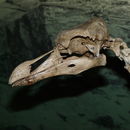en
names in breadcrumbs


Pezophaps solitaria, the Rodrigues solitaire, is an extinct, flightless bird that was endemic to the island of Rodrigues, the easternmost, smallest, and probably oldest of the islands in the Mascarene Archipelago, which lies east of Madagascar in the Indian Ocean. First mentioned during the 17th century, the Rodrigues solitaire was described in detail by François Leguat, a French Huguenot refugee marooned on Rodrigues between 1691–1693, and sailor Julien Tafforet, marooned between 1725–26. Soon after, by 1778, the Rodrigues solitaire went extinct, a result of human colonization of the islands in the 17th century which brought hunting and the introduction of non-native predators of the birds and their eggs.Apart from these accounts, a drawing (the only know picture drawn from a live bird) by Leguat, and a few other contemporary descriptions, nothing was known about the bird until a few subfossil bones were found in a cave in 1789.Thousands of bones have subsequently been excavated, yielding seven complete skeletons (Wikipedia 3 September 2014, 24 August 2014; BirdLife International 2012; Shapiro 2002; Hume and Steel 2013).
Recent genetic analyses (Shapiro et al. 2002; Pereira et al. 2007), confirm longstanding belief that the Rodrigues solitaire was the sister species to the also extinct dodo (Raphus cucullatus) of neighboring island Mauritius.Together these birds are considered family Raphidae or subfamily Raphinae, and clearly embedded in the dove/pigeon family Columbidae.Molecular clock analysis suggests the dodo and solitaire diverged from each other late in the Oligocene (about 25.6 million years ago), which interestingly is just about the time that land ridges emerged around the Mascarene plateau, and long before the evolution of Rodrigues or Mauritius islands.Shapiro et al. (2002) hypothesize that after diverging, the two birds island hopped (perhaps before losing their ability to fly) between evolving islands within the archipelago before each settled on their respective island of endemism.Since the fairly isolated island of Rodrigues is estimated at 1.5 million years old, it is possible P. solitaria retained its ability to fly until after this time (Hume and Steel 2013; Shapiro et al. 2002).
Leguat and Tafforet both provided lengthy and interesting morphological and behavioral descriptions of the solitaire, painting a picture of a bird with grey and brown plumage, females paler than males.Females were about 60% of the weight of males, a sexual dimorphism greater than any known in birds outside the ratites and tinamous. Solitaires were highly territorial, and aggressive especially when nesting and rearing young.Both sexes took turns incubating their single egg.Mature, breeding adult males (and to a lesser degree, females) grew a bulb-like growth of bone up to 3 cm (1.3 inches) in size on wing which, with its covering of calloused skin, made a deadly weapon the bird used for defending its territory and mate.Using highly developed muscle attached to its large keel bone, the birds swung their wings hard enough to make a noise like thunder as they crash the bulb into an aggressor. Solitaire bones found in caves on the island show many incidences of fractures, which are attributed to the results of wing battering in combat.The Solitaire’s remarkable carpal “musket balls,” (as described by sailors traveling to Rodrigues Island) are unique to this bird (Hume and Steel 2013; Wikipedia 25 August 2014).